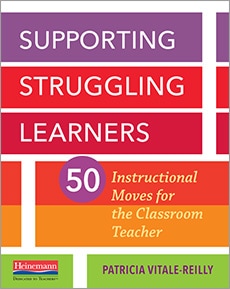Acknowledgments xiii
Introduction xv
What You Will Find in This Book xvii
Why This Book for Classroom Teachers? xviii
Who Are Struggling Learners? xviii
Chapter 1
Create an Inclusive Culture Through Structures and Environment 1
#1 Make Your Room and Walls Clutter Free (K–8) 2
#2 Offer Multiple, Flexible Seating Arrangements (K–5) 4
#3 Present Information in Multiple Media (K–8) 6
#4 Allow Students to Show Understanding in Multiple Forms (K–8) 8
#5 Embrace the Power of Yet (K–8) 13
KEEP IN MIND 15
Chapter 2
Harness the Power of Collaborative Learning 16
#6 Practice Collaborative Work in Centers (K–8) 17
#7 Establish a Culture of Collaboration to Support Peer Learning (1–8) 20
#8 The Power of Two: Use Partnerships (K–8) 23
#9 Model Collaboration by Using a Fishbowl Technique (K–8) 26
#10 Scaffold Student Talk with Scripted Options (2–8) 28
#11 Introduce Student Work Plans (2–8) 30
KEEP IN MIND 33
Chapter 3
Use Visuals in Teaching and Learning 34
#12 Incorporate Virtual Field Trips (K–8) 35
#13 Rethink Anchor Charts (K–8) 37
#14 Improve Retention with Sticky Note Prompts (1–8) 44
#15 Offer Support with Formula, Cue, and Goal Cards (2–8) 46
#16 Create Response Sheets (2–8) 49
KEEP IN MIND 50
Chapter 4
Scaffold Instruction Through Pre-Teaching 51
#17 Activate and Build Knowledge with an Updated KWL Chart (K–8) 52
#18 Pre-Teach so Students Can Pre-Learn (2–8) 54
#19 Incorporate Text Previewing and Introductions (K–8) 57
#20 Hook Students Through Authentic Digital Resources and Experiences (K–8) 59
KEEP IN MIND 62
Chapter 5
Incorporate Small-Group Instruction 63
#21 Decide on the Most Responsive Form of Small-Group Instruction (K–8) 63
#22 Implement Teaching Intensives (K–8) 72
#23 Use Planners to Manage Instruction (K–8) 75
#24 Make Small-Group Instruction Matter: Ask, What Is Getting in the Learner’s Way? (K–8) 79
#25 Record Keeping That Is Simple, Succinct, and Specific (K–8) 84
KEEP IN MIND 92
Chapter 6
Develop Learning and Study Skills 93
#26 Teach the Concept of Time Management Through a Reading Record (1–8) 94
#27 Provide Tools to Help Schedule and Manage Work and Projects (K–8) 96
#28 Introduce and Cultivate Focus (K–8) 98
#29 Develop Task Initiative (K–8) 100
#30 Develop Expertise Through Review and Study Guides (3–8) 101
#31 Explicitly Teach Study Strategies (1–8) 103
#32 Develop Note-Taking Skills (3–8) 104
KEEP IN MIND 108
Chapter 7
Teach Communication Skills 109
#33 Develop Conversation Skills Through Whole-Class Conversations (2–8) 110
#34 Support Auditory Understanding (K–8) 112
#35 Teach Students to Self-Advocate (K–8) 114
#36 Cultivate Presentation Skills (2–8) 115
#37 Teach Nonverbal Communication (K–8) 117
KEEP IN MIND 119
Chapter 8
Writing Instructional Moves That Help Students Across the Day 121
#38 Model in a Variety of Ways (K–8) 122
#39 Add Kinesthetic and Tactile Support for Writing (K–8) 123
#40 Get Writing Started by Offering Choices (K–8) 124
#41 Support Generating Ideas (K–8) 126
#42 Get Words on the Page Through Freewriting (3–8) 129
#43 Rehearse Writing to Plan, Organize, and Brainstorm (K–8) 130
#44 Use What They Know to Revise (3–8) 133
#45 Create Opportunities for Feedback (K–8) 137
#46 Scaffold Through Paper Choice and Tools (K–2) 139
KEEP IN MIND 141
Chapter 9
Home Support 143
#47 Establish Communication Protocols and Communicate Often (K–8) 144
#48 Make the Most Out of Back-to-School Nights (K–8) 146
#49 Help Parents and Caregivers Understand Their Child as a Learner (K–8) 147
#50 Help Parents Create Supportive Home Environments (K–8) 151
KEEP IN MIND 152
Chapter 10
If . . . Then 153
If You Need More Support 154
If You Need to Progress-Monitor a Student 157
If You Have a Co-Teacher or Teacher’s Aide 172
Final Thoughts 179
References 181
